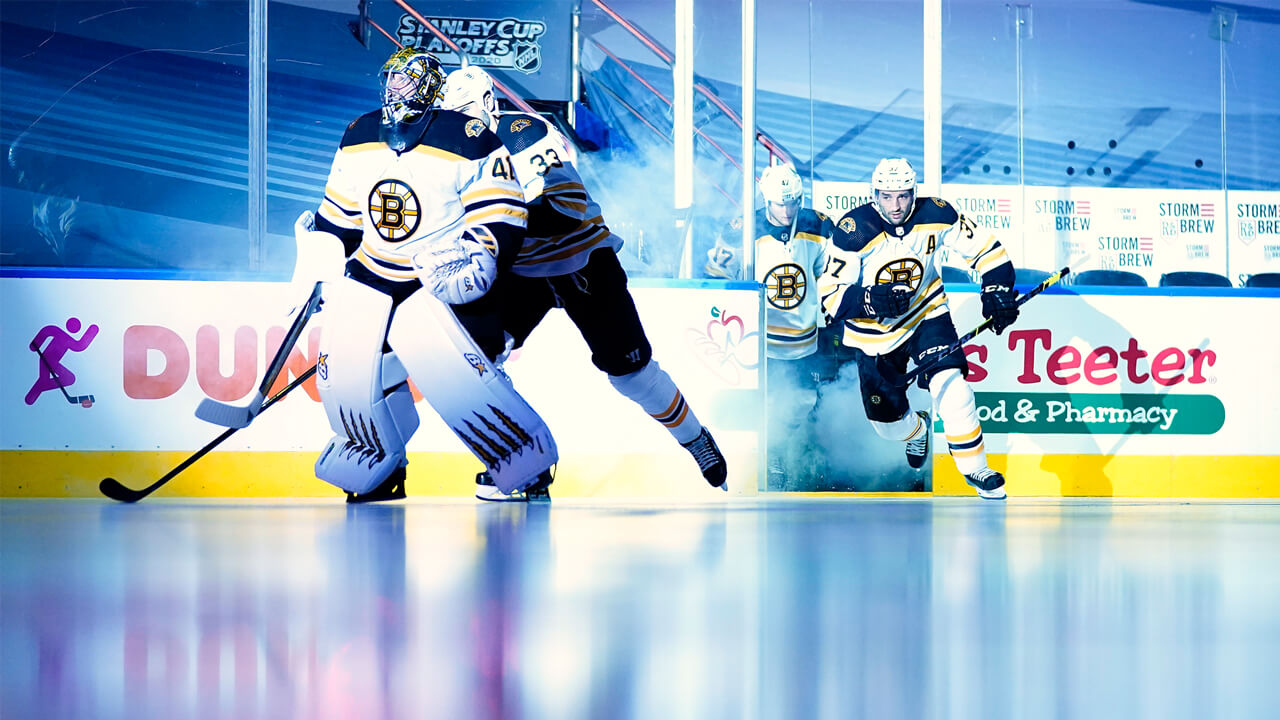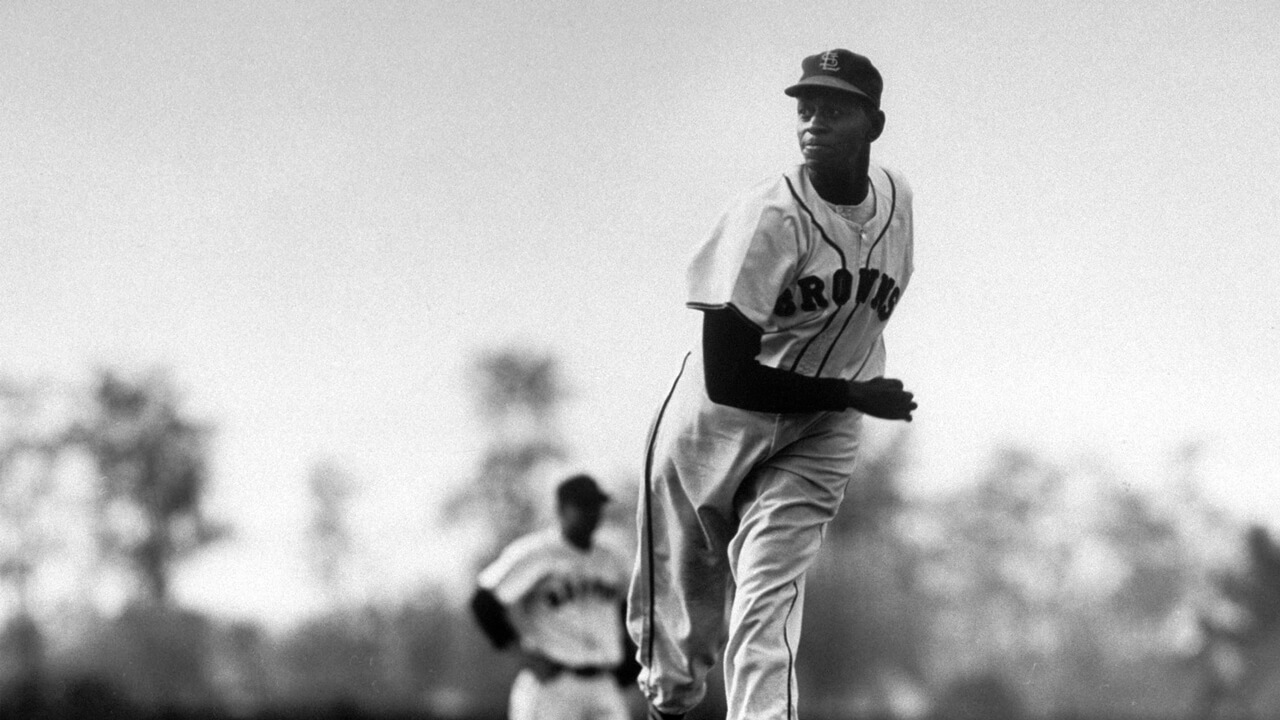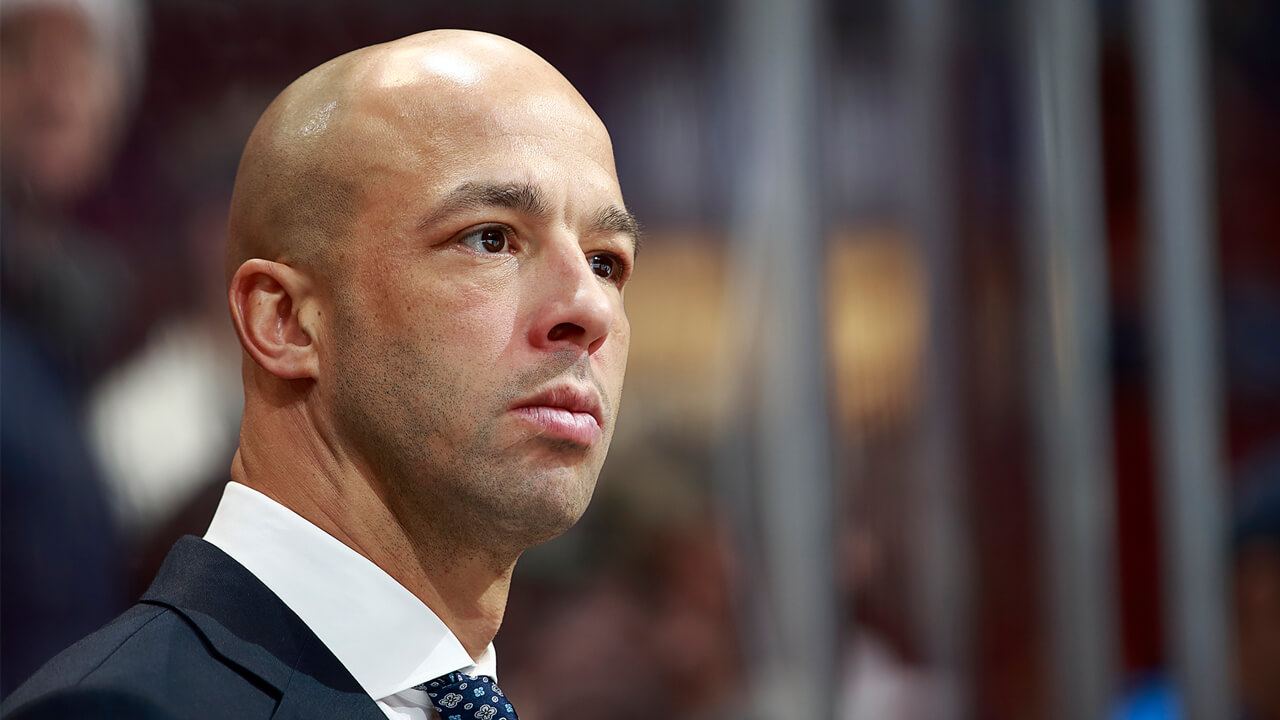I’m not sure how the NHL’s viewership numbers reflect the few hundred of them working from home who have been tuning in. Exactly where they fall in the audience demographics is hard to say. They range from their 30s to 60s; geographically, they’re hither and yon, both sides of the border. I speak of and spoke to NHL scouts, six veterans in all, who were a little more forthcoming under the cloak of anonymity than they may have been with their names and employers attached. Up for discussion was their industry’s spring showcase, which this year is playing out in deepest summer, the Stanley Cup Playoffs.
These are folks of varying professional fortunes, a couple own Stanley Cup rings, others work for teams that haven’t escaped the first round — when they’ve made the playoffs at all. But regardless of the level of success they’ve enjoyed in recent seasons, they, like everyone who carries a clipboard at the rink, dread summer hockey. Games are always on their schedules in July and August, albeit usually live-action. This time last year they had already taken in a few dozen that fell on the 2019–20 schedule: first, the international under-20 exhibitions at the USA Hockey facility in Plymouth, Mich.; then the under-18 Hlinka Gretzky Cup; then pre-season games in major junior; then the Traverse City NHL rookie tournament or its equivalent elsewhere.
“They’re all kind of painful to watch,” says one scouting director. “Scouts love to go to games, but not in summer. The hockey ranges from pretty bad to awful, depending. The intensity is really low. Play’s not physical. You’ve got kids who’ve never played together trying to find some chemistry in a week. There are some top prospects, yeah, but no one drafts or signs anyone on what they do in August. It’s not quite a pointless exercise, but none of us likes giving up on our summers to do what we spend months on the road for from fall to spring.”
These annual fixtures were early casualties of the COVID-19 lockdown. With them off the schedule, you might assume scouts could easily reclaim their downtime for R-and-R — all their teams’ draft planning is long put to bed. But the work continues, it’s just that instead of heading to Plymouth or Prague or Chicoutimi, NHL scouts are parked in their dens in front of big screens watching their teams play for the game’s biggest prize.
While the personal histories and professional fortunes of these scouts are wide-ranging, their bubble-viewing habits have not been: Five were in haven’t-missed-a-minute mode and said their staffs were likewise; the other, the youngest among them, said he’d been only a bit more than an occasional viewer. The latter explained that he was wrapped up in an apparent make-work assignment: a reassessment of every player on the organization’s depth chart along with its recent draftees. “I have to watch at least three games for each from last winter, a fair bit more with the drafted players,” he says. “I don’t think I’ve seen anything I missed or that changed my mind about anyone … just confirmed what I’ve always thought of them. It’s like I’m going to summer school to repeat a grade. It’s about as bad as summer hockey in general, I guess.”
NHL scouts are hockey’s toughest crowd. If there’s a knock on a player they’re watching, they’re bound to point it out and dwell on it. I told them that I found this summer’s Stanley Cup Playoffs pretty entertaining and expected them to correct me. That’s not how the conversations played out, though.

To begin with, I was mildly surprised that so many watched the games so closely. These are, after all, pairs of eyeballs that take in 200 to 300 games each season, save this coronavirus-interrupted one. Their interest was not hard to fathom, though. “Let’s face it, this is the longest I’ve ever gone without being in an arena,” one Western Conference scout says. “I had to watch hundreds of hours of video instead of getting out and watching games ahead of the draft. It’s all searchable stuff, so it’s not really as mind-numbing as that might sound. Still, highlights and replays only go so far. I was jonesing to watch games where I didn’t know how it came out.”
When play in the bubbles in Edmonton and Toronto began in late July, these industry experts went into it skeptical because, let’s face it, they’re professional skeptics. “I thought there might not be the usual playoff intensity,’ says one veteran scout who has worked with three organizations. “That was gone by the second shift of that first game in the Rangers-Carolina series. There was a crazy-high level of intensity in that play-in round. I liked the three-out-of-five format … just made it so urgent. Teams couldn’t afford to ‘get into’ a series — if they’re not into it right away, they’re out before they know it.”
One scout who joked about judging play based on “a small sample size, at least until the Lightning and Columbus go to five OTs” says no asterisk will need to be attached beside the name of the team that gets a parade. “A goal or a game can come down to a bounce, but whoever comes out of this [with the Cup] will have earned it, just not earned it like any other team before,” he explains.
All the scouts were impressed with the pace of the games as much as the intensity heading into the second round. “The speed has been there from the drop of the puck,” says one scout who’s planning on retiring next year. “The skill [and] the timing are still playing catch-up but it’s way better than I expected. I’m sure the skill is going to get a little closer [to the usual] with each round. They’re the best players in the world, so maybe we shouldn’t be surprised that they figured it out. [Boston’s first line of Patrice] Bergeron, [Brad] Marchand and [David] Pastrnak didn’t look like themselves in the seeding round but looked a lot better [against Carolina in the first playoff round] and were right back to mid-season stuff against Tampa [in the conference semi-final].”
Another pro scout says it’s simply a matter of time and games logged. “If they were starting in July like they would start at training camp in September, then by games played we’re looking at the type of level we’d [usually] see in November. Factor in the stakes, which have been raised, and maybe we’re seeing hockey like we’d see in your average December, which is when the players are really hitting on all cylinders.”
A couple suggest that their biggest surprise is that there were no surprises — that is, no unheralded players have emerged to steal the spotlight. Form, in their view, has held. “Those who are supposed to be the best have been the best,” an Ontario-based scout says. “[Jacob] Markstrom was the Canucks’ best during the season and it’s the same deal in the playoffs, getting them past St. Louis. [Mathew] Barzal, same thing with the Islanders. That’s the level they’ve established. [Auston] Matthews in Toronto was their best. [Carey] Price was Montreal’s best. Those two are supposed to be the guys based on what they’re paid. They were good, and I give them some credit, but they’re supposed to be.”
Yes, tough crowd.
One whose team is still in the dance says the most valuable players might have been “the guys who weren’t able to play,” pointing to Matthew Tkachuk in Calgary and Mark Scheifele in Winnipeg. “At least for a round, Tkachuk could show us what he could do and the impact that he could have,” he says. “As soon as he went down, you knew the Flames didn’t really have a shot. And Winnipeg losing Schiefele that first week, that was death for them. Neither team was deep enough to take a hit in their top-six forwards or top-four ‘D’ like that and have someone fill in, never mind the key guys.”
The fall of the defending Stanley Cup champion St. Louis Blues took one scout by surprise. “I’m not sure the Blues really came back from the lockdown,” he says. “They showed nothing [in the seeding round]. The Canucks shouldn’t have been able to compete with them never mind beat them. Maybe they just didn’t buy in or couldn’t flip the switch. They didn’t have a crazy amount of turnover from one season to next but they didn’t look like the same team as last spring or last winter.”
Most of the scouts say the absence of fans — games in what is essentially a stadium-sized television studio — was disconcerting to watch at first but had zero impact on play. The same goes for playing in deep summer. “The ice might not be great and it’s getting worse with more games, which sort of hurts the skill guys, but it cuts both ways,” one says. “On the upside, the ice would be better than a lot of times during the season just because it’s easier to keep the arena real cold [with no fans in it].”

What they’re convinced will impact games and decide series is the compression of the schedules. “It’s the quick turnarounds, the back-to-backs to fit in all the games in the early rounds, that’s what’s already beginning to show,” says a scout from a team that fell short of the second round this month. “You’re going to have to manage your goaltending differently than other playoff years. The way it worked out before you played one guy, play him start to finish because you could with the days between games and travel days that were built into the mix. Your No. 1 could count on being rested and recovered. If you’re playing back-to-backs with an overtime, maybe two or three, as the front end of a back-to-back, you’re going to have to go to your No. 2.
“You have to give an advantage to the teams that divided up the workload in the season,” he continues. “Boston would have been set up with Rask and Halak, but when Rask goes home — which you have to understand — it falls to Halak backed up by a guy [Dan Vladar] with 70 AHL games in four seasons. Tampa is in tough, too … They could get in a jam because they lived and died with [Andrei] Vasilevskiy all season and now you’ve got [Curtis] McElhinney who was in 18 games [this year]. We see this during the regular season but haven’t seen anything like that before in the playoffs… ever.
“Compare them to Dallas who have [Anton] Khudobin and [Ben Bishop]. They have two No. 1s. Same thing with Vegas, with [Robin] Lehner and [Marc-André] Fleury. Never mind the cartoon [a tweet from agent Allan Walsh of a drawing of Fleury being stabbed in the back by coach Pete DeBoer, alluding to Walsh’s client sitting while Lehner plays]. What looks like a problem is a strength. If the schedule sets up, Fleury’s going to play and probably play well.”
That is to say, one man’s storm cloud could be a team’s needed safety net.
There was no consensus about who lands where and how but most said that, for aesthetic value, they’d most like to see a Vegas-Dallas Western Conference final. “Those are the teams not just with the depth of goaltending but with deep lineups,” says one. “They just keep rolling really proven, experienced guys out at you. Dallas even has a third-liner [Corey Perry] who’s won a Hart Trophy, a Cup and two gold medals.”
The quality of the playoff hockey is helping to take the scouts’ minds off some industry-wide concerns, stuff that’s flying below the radar for even dedicated hockey fans but hits team staffers where they live and work. Only one of the scouts I spoke to had real cause to worry about whether he’d stick with his organization until next summer — although his team fell short of the post-season, he’s been kept on by management. While he alone in his group is worried about his job security, some developments are cause for universal concern.
Typically, scouts are on one-year contracts. They work through the draft in late June and, if retained, get new deals in the mail on July 1. Generally, a bit of movement is expected in any given year — some retire, some find coaching jobs, some are reassigned within their organizations. With the draft shifted to October this year, just about everybody stayed in place with the exception of Buffalo where the firing of GM Jason Botterill in mid-June set in motion a punting of virtually the entire scouting staff by his successor, Kevyn Adams.
Many expect changes in Florida, where the Panthers have cut ties with long-time GM Dale Tallon, and in Arizona following the messy divorce of GM John Chayka and the Coyotes. Says one scout sympathetically: “By the time [Chayka was out], he’d already gutted a real good scouting staff over the past few years.”
Even in Florida and Arizona, though, everyone is standing pat at least this summer. “Just about everyone got a slide for a year to see how this plays out with COVID,” the soon-to-retire scout explains.

None of the six scouts claimed to have a good idea of what their work is going to look like after the draft and into the coming season. “There’s going to be no getting to games internationally,” says the Western Conference scout. “Our guy in Sweden can’t leave the country. Games there will be played in empty arenas. In Finland, I think they’ll limit the crowd to 10 people in the arena and there’s probably going to be 20 [scouts] who want to get in. Russia is the loosest — they’re letting in 10 per cent of capacity — but is that a good or bad thing? Do you want to see games somewhere that’s lax [with precautionary measures]?”
It gets no better closer to home. Says a U.S.-based scout: “The USHL says they’ll be up and running this fall, and it might work out for them, but staff from Canada won’t be able to get to any games. I can drive it but who knows where there might be some sort of outbreak, games getting cancelled or [scouts] getting exposed [to COVID]?”
Says the Ontario-based scout: “The CHL is going to be broken up by the border. Saginaw and Erie are stuck on their side unless you arrange something with quarantining a team for a road trip … that’s not going to work. Same with teams in the Dub, though there are enough teams in the Pacific Northwest you might be able to work something out in the short-term. Even in the Quebec league you’ve got issues. The Maritimes have locked things up. And how is anyone gonna travel anyways to play in empty arenas? How are teams going to pay for road trips when they’ve got next to nothing for home gates?”
All that’s subject to change with, say, a vaccine. Then again, as bad as things are, they could get worse. The scouts I spoke to despaired not just of the immediate logistical inconveniences but also the long-term implications for their trade. They fear that COVID-19 will be a catalyst for a paradigm shift for NHL scouting, something that goes deeper than war rooms becoming war Zooms. “I think everything is going to be changed from here on,” says the scout whose team didn’t make the playoffs. “Scouts have been doing a lot more scouting by video over the years. This season [the 2020–21 campaign] is looking like it’s going to be almost entirely by video. We won’t be able to travel to see [the 2021 draft class] but we’ll still have a draft next June or whenever. We’ll still get it done. And owners will say, ‘If you could do it with less overhead, do it again like that.’ You don’t have to try very hard to convince owners to spend less.”
Adds the Ontario scout: “We might have seen the last draft in an arena set up the way we’re used to. It could be online or in-studio or something like that. Some team presidents and GMs have been pushing for it for years. Something like the NFL draft, something meant for broadcast. I mean, it’s a great event for everybody, something really special, but for the owners it’s a cost.”
For all the doom and gloom about their jobs in the years that lie ahead, some see a cause for hope. “I thought it was a longshot that the league would be able to have playoffs,” says the scout who’s near retirement. “I figured there’d be outbreaks of coronavirus, players dropping out, teams dropping out. It hasn’t played out like that. You look at Rask, sure, but then look at Maxi Domi [who was seen to be taking a greater-than-average risk because of diabetes]. Domi was committed to playing. The players got on board even though no one knew what this would look like or if it had a chance.
“It’s pretty crazy when you see what they’ve managed to pull off in the bubble. Things are probably going to change, for sure, but the league made the best of an impossible situation, so maybe the scouts will be able to as well.”



